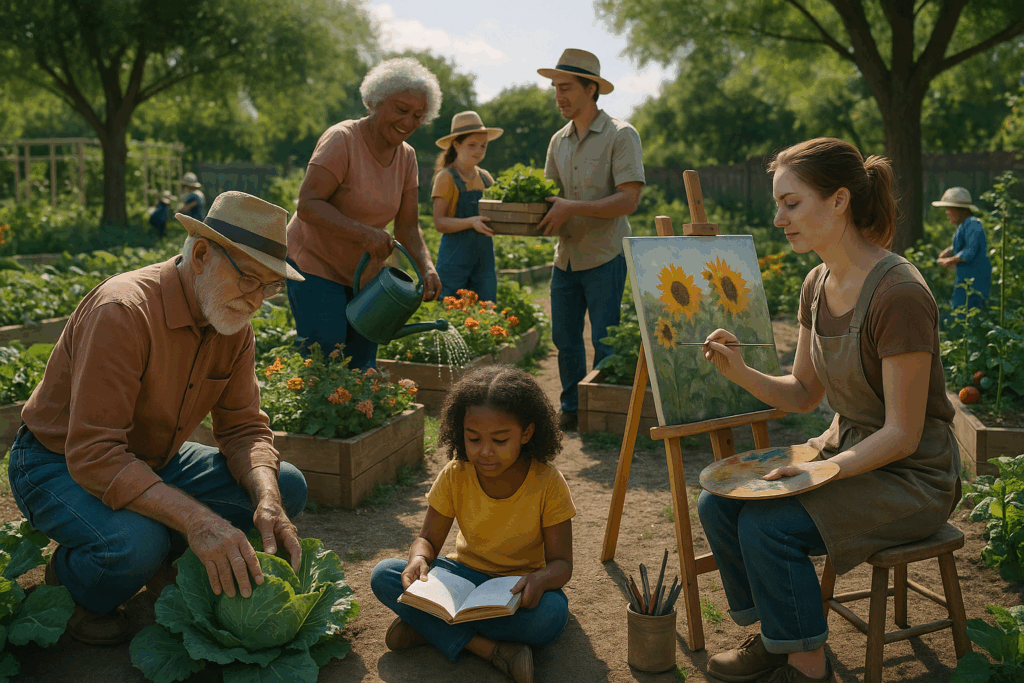
The Power of Imagination
Rob Hopkins, co-founder of the Transition Town movement, brings his activist energy and hopeful vision into From What Is to What If. His central claim is simple but radical: imagination is the most powerful tool we have for shaping the future. Yet, he argues, we live in an “imagination crisis” – a cultural moment where creativity, vision, and collective dreaming are being eroded by busyness, fear, and narrow thinking.
For Hopkins, reclaiming imagination is not a luxury. It is the foundation of building resilient, regenerative communities capable of responding to the climate crisis, inequality, and social fragmentation.
Asking “What If?”
The book’s title signals its method. Instead of being locked into “what is” — the current systems, habits, and assumptions that dominate our lives — Hopkins invites us to ask “what if?”:
- What if communities were designed around connection, not consumption?
- What if schools encouraged curiosity rather than conformity?
- What if we measured prosperity by well-being and ecological health instead of GDP?
By asking these questions, Hopkins argues, we begin to unlock dormant possibilities. Utopian thinking becomes practical when grounded in imagination and experimentation.
Beyond the Dominant Paradigm
Hopkins critiques the dominant paradigm that equates progress with economic growth and frames individuals as isolated consumers. In its place, he points to projects from around the world where people are already living out alternatives — urban farms, community-owned energy projects, repair cafés, and imaginative cultural experiments. These examples serve as seeds of hope, showing that another way is not only possible but already beginning.
This is why the book resonates so strongly with my Beyond the Dominant Paradigm series. Hopkins reminds us that paradigm shifts don’t happen through critique alone – they require us to cultivate imagination as a shared practice. It is not enough to analyse the brokenness of “what is”; we must also nurture the courage to envision “what if.”
Stories That Spark Possibility
One of the book’s strengths is its grounding in real stories. Hopkins travels widely to share examples of communities using imagination to re-shape their reality: children redesigning city streets, artists reimagining public spaces, local projects tackling climate change with creativity rather than despair. These are not abstract theories but tangible glimpses of a different future emerging in the present.
A Hopeful, Practical Guide
Hopkins balances urgency with optimism. He does not downplay the scale of the crises we face, particularly the climate emergency. Yet he refuses the narrative of hopelessness, insisting that hope grows when we act, create, and imagine together. His writing carries the spirit of an activist who has seen communities achieve extraordinary things when given the chance to dream.
This makes the book both inspiring and practical. It offers not just a critique of the imagination deficit but a call to cultivate imagination in daily life – through storytelling, play, art, and collective experiments.
Why It Matters
In an era of ecological breakdown and cultural fatigue, From What Is to What If insists that imagination is not optional. Without it, we remain trapped in systems that are failing. With it, we can open space for renewal, resilience, and joy.
For me, this book is a companion piece to others in the Cultural Shift & Collective Purpose theme. It sits alongside works like Rutger Bregman’s Utopia for Realists in affirming that bold change begins with daring to imagine differently. Hopkins shows us that “what if” questions are not idle speculation – they are the seeds of transformation.
If this article resonated with you, I’d love to share more.
When you join the monthly Soulful Path newsletter, you’ll also receive my free guide:
Walking the Soulful Path – How to Bring Purpose and Meaning into Your Everyday Life.
It’s a simple, soulful resource to help you weave meaning into the moments of daily living.
